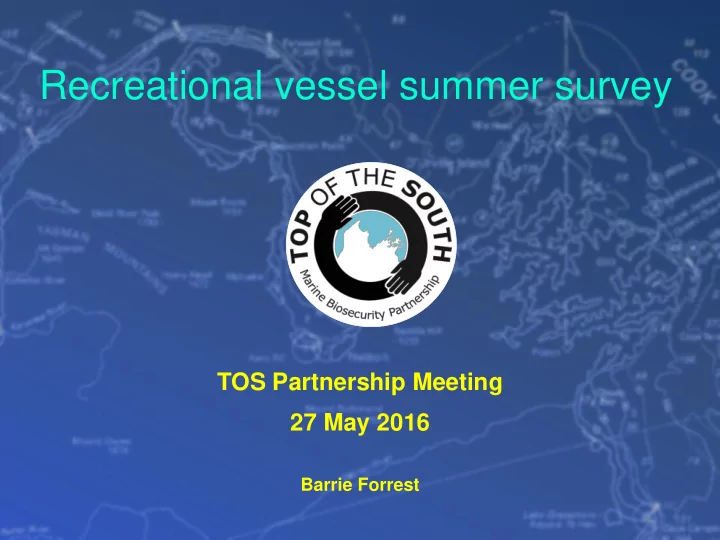

Recreational vessel summer survey TOS Partnership Meeting 27 May 2016 Barrie Forrest
Context Recreational vessels • Numerous in TOS • Prone to biofouling - many boats at Nelson and Waikawa marina and/or moorings have ‘conspicuous’ or ‘high risk’ fouling • Fouling survives at slow voyage speeds • Often visit high-value coastal areas
Questions regarding regional risk • Biofouling risk profiles of regional recreational boats, especially boats in active use? • Boater habits: Where are boaters from? Where do they travel? What are their maintenance practices, etc • Focus on boats berthed or moored (not trailered boats)
Three-pronged attack 1. Field survey of fouling status of boats around the TOS region 2. Boater questionnaire via face-to-face interviews, boat drop off or email distribution (included “keep your bum clean” info packs) 3. Combined boat fouling assessment and boater questionnaire at Nelson and Waikawa travel-lifts g potential to generate large dataset to explore drivers of fouling
Regional field survey • Snorkel survey of fouling on 226 boats during peak summer holiday season, and delivered info packs • Boat support from Harbour Masters (Tasman, Marlborough) and DOC (Marlborough) Pelorus Tarakohe (26) Sound (43) Boats snorkelled came from: Queen • TOS = 216 Charlotte Abel Sound (127) • NZ = 8 Tasman (30) • International = 2 Nelson Waikawa
Level of fouling (LOF) assessment Macrofouling LOF Description cover (%) Slime layer fouling only. Submerged hull Increasing likelihood of marine pest 1 areas partially or entirely covered in Nil biofilm, but absence of any macrofouling Light fouling . Hull covered in biofilm and 1 – 5 2 1-2 very small patches of macrofouling (may be only one species) Considerable fouling . Presence of biofilm, and macrofouling still patchy but 6 – 15 3 clearly visible and often one or several different species Extensive fouling . Presence of biofilm, 16 – 40 4 and abundant fouling assemblages usually consisting of many species Very heavy fouling . Diverse fouling 41 – 100 5 covering most of visible hull surfaces Modified from Floerl et al. 2005
Target fouling pests Styela clava Sabella spallanzanii (clubbed sea squirt) (Mediterranean fanworm) Eudistoma elongatum (droplet tunicate) Pyura doppelgangera
Other pests of interest Undaria pinnatifida (Asian kelp) Didemnum vexillum (sea squirt)
Boat levels of fouling Summer survey 2015/16 vs Nelson and Waikawa in 2013 & 2014 Summer survey boats that were in active use vs boats of unknown activity status
Boats with target pests Sea squirt Styela 3 boats Fanworm Sabella (+ 3 moorings) From Nelson From Wellington
Secondary pests Kelp Undaria Sea squirt Didemnum (underestimate due to seasonality) 55 boats 23 boats (24%) (10%) 45 moorings 48 moorings (33%) (36%)
Niche area issue Pests present even at low levels of fouling g ‘niche’ area problem
2. Boater questionnaire • Delivered > 1000 questionnaires • 215 returns from TOS + a few from Wellington Preliminary results…. •
Boater maintenance & use • Generally regular antifouling but most boats spend most of their time idle • 35% of boaters had cleaned their hull since last antifouling of which: 56% cleaned in-water 10% cleaned on a beach or intertidal area
Boater origin & activity • c. 10% boats from outside TOS (18 NZ, 2 international) 75% of external boats don’t always visit a vessel hub (e.g. • local port or marina) • High connectivity across TOS
Synthesis: recreational vessel risk • Recreational boats probably pose a high risk to many of the locations with important values in the TOS • Despite typically regular antifouling, there are many conspicuously fouled boats voyaging throughout the TOS, and many are carrying marine pests • The prevalence (on boats and moorings) of pests like Undaria is probably a good indication of the medium-term distribution of more recent arrivals like Styela and Sabella • Wellington a key source region to the TOS (especially the Sounds), with many visiting boas travelling directly to holiday spots and not main vessel hubs Small ports like Tarakohe can’t be overlooked as important hubs • for the spread of pests within and beyond the TOS
Management implications (preliminary) • Manage vessels better at source hubs within and beyond the TOS (e.g. Wellington) • Need less-fouled boats leaving home base: Limit boat fouling by berth agreements? Consent conditions for moorings? Affordable infrastructure for cleaning/antifouling Sensible guidance/rules around in-water cleaning (e.g. ANZECC, Auckland Council) Practical measures to address niche area fouling; especially ways to improve antifouling on the keels of yachts Population control in hubs? Are there affordable “generic” • solutions?
Recommend
More recommend